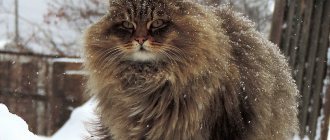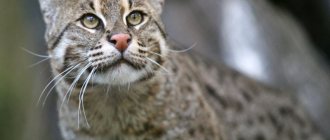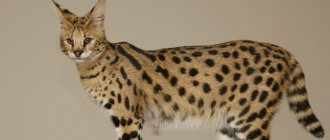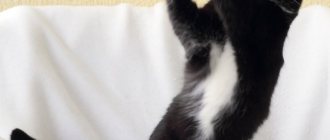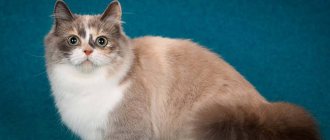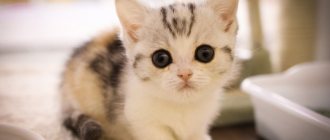The Chinese Li Hua is one of the oldest breeds. It arose as a result of the domestication of wild mountain cats. Often these animals are also called Dragon Li or Li Mao. Despite the fact that even in their homeland they are quite rare, they are very loved and revered there. In other countries, only connoisseurs have heard of them, since this breed is quite small in number.
History of the discovery of the species
It is not known for certain where the animals came from; they approximately inhabited the territory of China long before the appearance of people and lived in desert areas. The separation of the Chinese and European (forest) cats occurred 230 thousand years ago. The cat was first described by the French zoologist and naturalist Henri Milne-Edwards in 1892. These animals lived in China long before the appearance of pets in Europe, where they were brought after the opening of economic borders.
Today, the Desert Cat is a small species, numbering from 2,500 to 10,000 adult individuals according to various sources, and these data are inaccurate. Not all animals have been domesticated by humans; small groups live in the remaining undeveloped areas of China.
Today they are facing extinction, as residential and industrial buildings occupy new territories every day, leaving no room for wildlife.
Mr. Cat recommends: characteristics, habitat
The appearance of the Chinese mountain cat is not much different from the domestic animal we are used to. It is larger than its European counterparts, but very similar to them. In addition, he is practically a copy of the jungle cat, although his paws are slightly shorter, but he also has tufts on his ears. The animal's muzzle is extended forward, its coat color is yellowish-red with characteristic stripes. By the way, in Chinese the name of the species sounds like huang mo mao, which means a cat with yellow fur.
Forest or European cat
jungle cat
Chinese cat
In addition, we can say that the Desert Cat is similar to a lynx, only different in size. The tail is thick with black transverse rings located towards the end.
Wild individuals reach up to 1.4 meters in length including the tail (it is 25-35 cm) and weigh 6-9 kg. Males are larger than females.
In nature, they can be found in the northwestern part of China. The animals live in steppe and mountainous regions near the border of Tibet and in southern Mongolia.
Observations by local residents indicate that Gobi cats live in extreme conditions at an altitude of 2000 to 4000 meters above sea level in the steppes of the foothills. Sharp temperature changes reaching critical levels in winter and summer, strong winds - these are the conditions chosen by the most ancient representatives of the cat family.
In the process of evolution, the fur of these animals became denser and thicker, and peculiar slippers were formed on their paws, protecting the pads from cold and heat.
Previously, the animal was an object of hunting. As a result of this, and also due to the mass extermination of rodents that the animal ate, the number of Mountain cats decreased. Now they are under state protection and are listed in the Red Book as an endangered species.
Description of the standard appearance of the Dragon Lee cat
All representatives of the breed have a muscular and strong build, although they are of medium size. So the weight of cats is 3.5 kg, but males will be larger, their parameters do not exceed 5 kg.
- The body
is characterized by proportionality, the body is slender, while its outline resembles a rectangle with a wide chest. The length of the body exceeds the height parameters. If you look at a cat from the side, its back should appear almost completely straight. - The head
of cats of the Li Hua breed has an elongated shape, with a rounded forehead. It is curious that the corners of the pet’s mouth are distinguished by a black color, which gives the impression that the cat is constantly smiling. - The eyes
are quite large, their contours resemble almonds, the eyes are set obliquely (the inner corner is always higher than the outer). Their color stands out very brightly against the background of the fur - it takes on shades of green or yellow. - The ears
are medium in size, widening at the base, while the top is rounded. - limbs
are equal in length or the front limbs may be shorter in length than the hind limbs; they are distinguished by straight outlines and muscularity. - The paws
of Li Hua Mau cats are large, oval and wide in shape. There are five toes on the front paws and only four on the hind paws. - The tail
is slightly shorter in length than the body; at the base it has a thickening that smoothly tapers towards the end. - The coat
of Dragon Li cats is short, smooth, soft and silky to the touch. The undercoat is very weakly expressed. The wool covering is dense and has two layers. Typically, females have softer fur than males. - The coat color
of representatives of the Li Mao species is only chocolate broken tabby-merkel or brindle black tabby. There are stripes on the body and head of the animal, the chest seems to be decorated with a necklace (at least one continuous stripe), black lines also follow from the eyes and the lower outlines of part of the cheeks leading to the neck, the belly is covered in specks of a black tone, the tail process has black ring markings , which also move to the limbs. The legs above the wrist take on a brown color. The tail is black at the top. These patterns make Li Hua's cat look quite striking, as the tabby pattern stands out clearly against the ticked coat. All this is due to the fact that each individual hair has a color of encircling stripes, which are black in the root zone, the middle zone has a light shade, and at the top it changes to a chocolate tone. Full maturation of an animal is possible only when it reaches three years of age. Kittens of the Dragon Li breed are offered for sale only when they reach one year or 16 months. Then you can not only transport them, but also take them to exhibitions.
Important!
Although representatives of the Li Hua breed are similar to yard cats, there are also signs that can disqualify them - an incorrect bite, the presence of extra toes on the paws, defects in the tail process, elongated or wavy hair, whitish paws of the same color. the muzzle, the tip of the tail are not black, the nose is lightened, there are no stripes on the chest that resemble a necklace.
Features of behavior
Like all representatives of the cat family, animals are predominantly nocturnal. At dusk, you can spot a beautiful predator in the bushes waiting for prey. Cats are secretive, leaving their home with extreme caution, trying to make it as secure and unnoticeable as possible. Hollows and crevices are chosen for homes; these are mainly refuges for males. Females prefer burrows with a complex branched system and several exits. They carefully protect their habitat; offspring are bred here, which are encroached upon not only by people, but also by large predators such as bears and wolves.
Mountain cats are solitary and rarely gather in packs, only for the breeding season. The rest of the time they live in solitude, guarding with all zeal the boundaries of the territory, which can occupy up to 15 square meters. km.
Domesticated individuals are distinguished by an easygoing disposition, affectionate and surprisingly devoted to their owner. This trait, unusual for the cat family, attracts breeders. Despite this, Chinese cats can be aggressive, so they are not recommended for families with small children.
Chinese "dragon" with a bunch of names
The Dragon Li cat breed has many names in Chinese sources, but is more often referred to as Li Hua or Li Mao. These felines became especially popular in 2003, when they were first presented at an international exhibition. After that, they gained popularity in the USA, but in Russia they never took root (due to their similarity with ordinary “yard” cats).
Due to its striped appearance, the Li Dragon is the "image of the tiger" to the Chinese - symbolizing fearlessness, ferocity and military prowess. It is also believed that his image drives away evil spirits. In this connection, cats of this breed are a talisman and a talisman of housing for the Chinese.
All representatives of Dragon Li are strong and muscular animals of medium size. The weight of males can reach 5 kilograms, and females up to 3.5 kilograms.
The appearance standard of the Dragon Li breed can be described by the following characteristics:
- The head is elongated towards the nose, with a rounded occipital part. The corners of the mouth are highlighted in black, which creates the impression of a “smile.” Be sure to have a dark tip of the nose - this is one of the distinguishing characteristics of the breed. The eyes are set slightly obliquely (the outer corner is always lower than the inner) and almond-shaped. Mostly presented in yellow or green shades (they stand out brightly against the background of the color of the coat).
- The ears are large but proportional. At the base they are quite wide with a rounded top.
According to the standards, individuals with the following characteristics are rejected:
- long wool;
- malocclusion;
- large ears;
- nose without darkening;
- extra fingers;
- there is no characteristic “necklace” on the chest;
- overweight;
- non-standard eye shade;
- fuzzy fur pattern;
- lack of slanting.
All of the above can serve as evidence of the absence of a breed or mixing with other species.
Puberty and reproduction
Chinese mountain cats breed in nature from January to March inclusive. During this period, animals gather in small flocks. Young animals reach sexual maturity early; already at 8-12 months they are capable of independent life and reproduction.
Pregnancy in a female lasts up to 2.5 months. During this period, the cat prepares a hole, landscaping it and creating a network of tangled passages for protective purposes. The offspring will appear in a secluded place at the right time, usually 2-4 babies. Breastfeeding the cubs does not last long; very soon young cats begin to learn to hunt under the control of their mother. By 7 months of age, the animals are completely independent and leave to look for their territory.
Captivity
The Chinese desert cat is listed in the Red Book, so keeping an animal at home is punishable by law.
Despite the prohibitions, you can find exotic animal babies on the black market. When purchasing a wild animal that is not adapted to living at home, you need to understand that improper care, territorial limitations and nutrition can lead to negative consequences.
A Chinese cat, accustomed to freedom and harsh natural conditions, can get sick and die in the house.
When feeding domesticated predators with natural products, the owner faces difficulties in selecting and balancing the diet, but for experienced breeders this is not a problem.
Purchasing a kitten
Purchasing a wild animal with the character of a predator is a responsible decision. The animal needs a large territory and loneliness; individuals, accustomed to living alone in nature, are forced to be in the spotlight and show aggression.
It is especially dangerous to keep a Mountain Cat with other animals. Pets will conflict and can cause irreparable harm to each other. Victory will be on the side of the wild animal, which is stronger and larger than domestic ones.
Breeders need to know that sterilization of the Chinese mountain cat is contraindicated. He does not tolerate anesthesia well and if he survives, his character changes for the worse. Keeping such animals outside the cage is dangerous for the owner.
When purchasing a pair, even experienced breeders take risks. It is impossible to be sure that animals will be able to reproduce in captivity, since the choice of a mate in cats usually occurs during the breeding season. During the rut, animals that have not found a mate become aggressive towards their own kind, and at home they can attack the owner, perceiving him as a rival.
There is no question of the Mountain Cat living in an apartment. This is deliberate murder. Living in a closed space leads to illness and death of the pet. It is impossible to toilet train an animal; it will mark its territory no matter what, as this happens in nature.
Considering the characteristics of the animal, it is better to leave it to live in nature or, in extreme cases, in a reserve or zoo with excellent conditions and competent specialists. For the home, it is recommended to purchase artificially bred breeds adapted for small spaces and constant contact with humans.
Breeds derived from the Chinese Mountain Cat
For exotic lovers, special breeds were bred from crossing with the Chinese mountain cat, capable of living in houses and apartments:
- Li Hua or Dragon Li is distinguished by an elongated muzzle and rather large ears. The color is spotted or striped, the main shade of the coat is brownish-red. This breed is attracted by its unusual amber eye color.
- The Li Mao or Chinese Fold is not an officially registered breed. It is believed that cats with floppy ears can only be Scottish. How Li Mao appeared is unknown. The color of the animal is grayish-brown with dark stripes. The tips of the ears are black.
Artificially bred pets are different from wild mountain cats. The animals are smaller in size and only resemble their relatives in color. They are not fussy about their diet and have a good appetite. For them, a diet is prepared based on industrial feed, canned food or ordinary products prepared independently. The choice of food depends on the characteristics of the animal. That is, they take into account the animal’s lifestyle, whether it is sterilized, as well as its age and build.
Kurilian Bobtail
- Height: 25.4-35.6 cm
- Body weight: 3.6-5.5 kg
- Lifespan: 14-20 years
- Temperament: Playful, energetic, affectionate and friendly
The Kurilian Bobtail is native to Sakhalin Island and the Kuril Archipelago. This is a natural cat breed , meaning that it was created through natural selection and not through any human manipulation.
Kurilian Bobtails mature very slowly and reach full growth at about five years of age.
The active Kurilian Bobtail has a playful disposition and loves to hunt. This breed is also known for its ability to fish, and they have waterproof fur so they don't mind getting wet. Tiny pets such as hamsters and guinea pigs should be kept away from Kurilian Bobtails, who view all small creatures as potential prey. However, they usually get along well with other cats, dogs and children.
Interesting Facts
Many sites write about supposedly another breed of Chinese cats, Maneki-neko, a symbol that brings happiness. In fact, this figurine, which is often made of porcelain or ceramics, came from Japan, not the Middle Kingdom, and looks like a cat waving its paw. It is sold in souvenir shops and is believed to bring prosperity and happiness to the home.
The history of Maneki-neko began in the early 17th century, when one poor monk sheltered a wild mountain kitten dying of hunger. The temple in which the man lived was in a terrible state. One day, out of melancholy and hopelessness, the monk spoke to the animal, saying that he did not blame him for being useless, but if the cat were a person, he could be more useful.
The next day a thunderstorm broke out. A prince was driving past the monastery and saw a Chinese cat on the road waving its paw. The beast showed the way to the shelter, where the traveler found food and shelter. The next day, a wealthy guest allocated funds for the restoration of the monastery.
Since then, Maneki-neko has been in every home and it is believed that happiness and good luck always follow it.
1111
Character
“Crouching Tiger, Hidden Dragon” is an artistic interpretation of a Chinese expression, the meaning of which corresponds to the Russian proverb “There are devils in still waters.” Among domestic cats, the Chinese cat Li Hua is a dragon, calm and wise, pliable, and forgiving. In Chinese culture, dragons represent everything bright and positive. By the way, Europeans and Americans, when talking about Li Hua, call these cats Li's dragons. So, in every peace-loving dragon there lives a tiger - a warlike, merciless, but fair punisher. Don't believe me? Then try to offend Li Hua or violate her boundaries without the owner’s consent - the affectionate, good-natured cat immediately turns from a peaceful “dragon” into a ferocious “tiger”.
But Li Hua is not a bloodthirsty person at all. You just need to treat these cats with care and a bit of respect. Li Hua cannot achieve anything by force, shouting and coercion. To the credit of the breeders, the Chinese cat is endowed with tolerance and wisdom - these animals are easy to raise, they understand a person almost without words.
